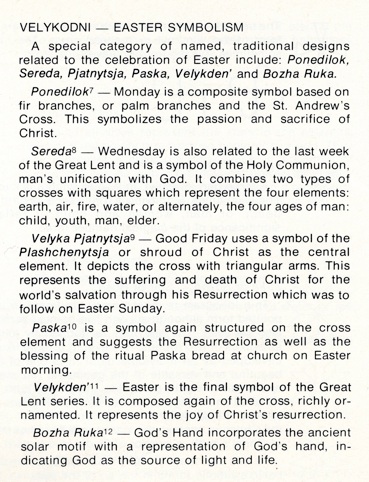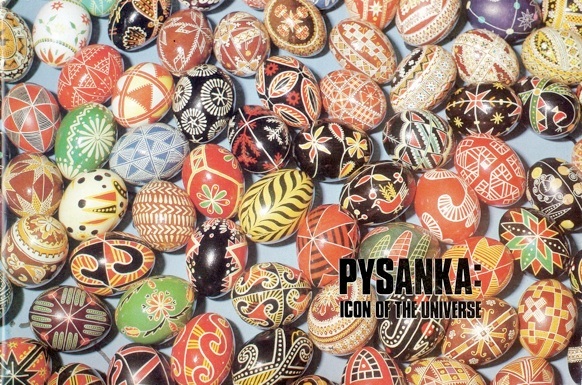
Pysanka: Icon of the Universe
Author: Mary Tkachuk, Marie Kishchuk, Alice Nicholaichuk
Format: Softcover booklet
Pages: 46
Language: English
Illustrations: BW, with 8 color plates
Publisher: Ukrainian Museum (Saskatoon, 1977)
Availability: yes, online retailers (Yevshan)
Acquired: unknown
ISBN: N/A
This book may be small, but it packs a big punch. It is a wonderful and inexpensive resource for anyone interested in traditional pysanka and their symbols and patterns.
The authors discuss the history of the decorated egg in Ukrainian culture, and its many variations (pysanky, krashanky, krapanky, etc.), as well as various folk beliefs relating to the pysanka. There is a section on how to make pysanka and other Ukrainian folk eggs. But these are not the strengths of the book–rather, those lie in its dissection of traditional folk motifs (symbols) and designs (the arrangement of motifs).
There is an extensive discussion of of symbols, which are grouped into families of motifs (solar, lines, plant, animal) , and designs (e.g. “The Call of Spring”). Examples are given of all with explanations. One caveat, though: the meanings of the symbols, as given in this book, seem to skew to a diasporan/Canadian interpretation, rather than a more traditional one.
I found the design eggs to be fascinating: Nebozvid (Universe), Call of Spring, Birds, Kola-Obruchy (Encircling Bands), Berehynia, Koroleva (Queen), Forty Triangles, and Heavenly Gates. These appear to be traditional designs of true Ukrainian origin.
Something I haven't really seen addressed elsewhere are a set of Easter designs based on the days of Holy Week:

Plate: Illustration of Holy Week pysanka cycle

I had never heard of these, and neither have Ukrainian experts I questioned. Their guess is that this is a diasporan tradition, perhaps based on an old local tradition in some region of Ukraine. The highly intricate style of the designs also suggests either a modern origin or a modern adaptation.
The illustrations are a mixed bag. While the line drawings used to illustrate the various symbols are quite good, the color plates leave a bit to be desired–the pysanky are extremely small, and the details of the pysanky hard to make out.
The front and back covers, though, show a plethora of traditional pysanky in full kodachrome glory. Many of the designs seem to be taken from Binyashevsky, including the yellow and black egg in the center of the front cover; that design is not a traditional pysanka design, but an example, in Binyashevsky, of the ceramic eggs produced in Kyivan Rus (medieval Ukraine).
This is a useful book, despite its shortcomings, and a useful addition to any pysanka library. It is somewhat difficult to find nowadays, and some sellers have taken to marking up the price dramatically (over $20). Looking around may help you find a less expensive version. And you can peruse some of the text and line drawings here.
Back to MAIN Pysanka Books home page.
Back to MAIN Books home page.
Back to Pysanka Bibliography.
Search my site with Google




